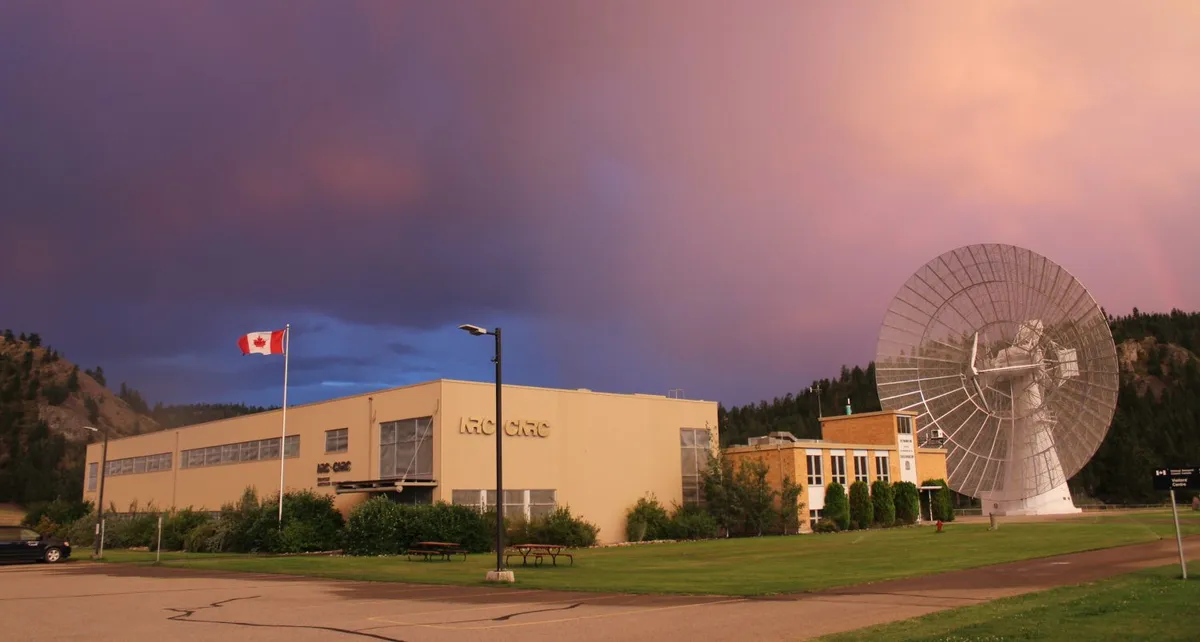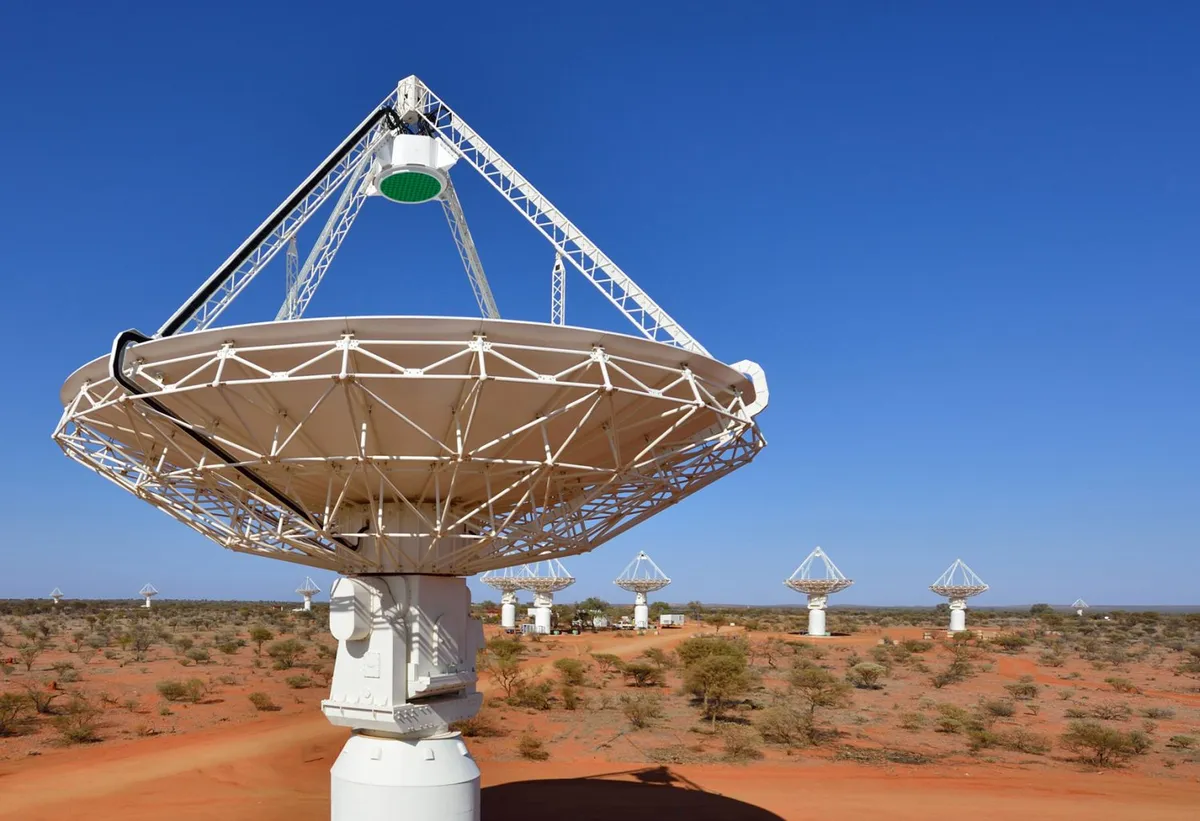It’s a weird sight in the pastoral landscape of Kaleden, south of Penticton, British Columbia. Close to the 25.6-metre dish of the John A. Galt radio telescope of the Dominion Radio Astrophysical Observatory lie four huge halfpipe-shaped cylinders of white painted steel and wire mesh, side to side.
They have no moving parts and look like no other telescope you’ve ever seen.
Yet, the Canada Hydrogen Intensity Mapping Experiment (CHIME), as the instrument is known, is shedding light on one of the biggest mysteries in astrophysics: the origin of fast radio bursts (FRBs).
What are fast radio bursts?
Fast radio bursts are ultra-short, ultra-powerful explosions of energy in remote galaxies.
In just one millisecond or so, they can emit as much power as half a billion suns.
Still, no one ever knew about them until 2007, when the first one was detected.
The reason: they just don’t last long enough to be easily noticed.
Moreover, you never know where the next one will pop up, and since radio telescopes generally have a very small field of view, the chances of catching one are minute.
Little wonder that astronomers remain pretty clueless about their true nature and origin.
Surprisingly, a fast radio burst first detected on 2 November 2012 (FRB121102) turned out to produce multiple (albeit very irregular) flashes.
This enabled scientists to pinpoint the origin of the bursts to a tiny dwarf galaxy at a distance of some 3 billion light-years.
For the first time, it was possible to calculate the tremendous energy of the mysterious phenomenon.
But was this repeating source really similar to the one-off radio bursts, or could it be a totally different beast?
Much uncertainty remained.

And that’s where CHIME comes in. Earlier this year, the novel radio telescope announced the discovery of a second repeating source, FRB180814.
And on 9 August, the CHIME/FRB Collaboration submitted a paper to The Astrophysical Journal describing a whopping eight new FRB repeaters.
As the authors write in their abstract: “these repeating FRBs will enable…localizations and subsequent host galaxy identifications that will shed new light on the origin and nature of FRBs.”
Indeed, within a few days after the online publication of the new results, astronomers had started to link some of the new repeaters to known galaxies.
So what makes CHIME such a prolific flash hunter?
It’s basically its huge field of view, measuring 120 by 10 degrees on the sky, says University of British Columbia astrophysicist Alex Hill, who gave me a private tour of the telescope during a visit in late May.
Each of the four cylindrical antennas has a length of 100 metres and a diameter of 20 metres.
CHIME produces 13 terabits of raw data per second. That’s more than the global internet traffic. Our energy bill amounts to 170,000 Canadian dollars per year.
Alex Hill, University of British Columbia.
The wire mesh on the cylinder’s surface (which actually has a parabolic cross-section) reflects low-frequency radio waves to an array of 256 receivers in the focal line of the huge antenna.
A powerful supercomputer known as a correlator turns the immense flood of data into a radio map of the sky.
"CHIME produces 13 terabits of raw data per second," says Hill. "That’s more than the global internet traffic."
He takes me into the correlator room, located next to the telescope, where I can hardly hear him because of the sound of the ventilators that cool the immense racks of computers.
"Apart from manpower, cooling the correlator is the largest cost item," he says. "Our energy bill amounts to 170,000 Canadian dollars [some 105,000 pounds] per year."
Since CHIME is not observing on the day of my visit, Hill allows me to go up to the focal line and to walk high above the full length of one of the antennas.
The wire mesh is wide enough to let snow fall through during the winter; a simple fence surrounding the telescope keeps grazing cattle out.

Despite its size, the whole facility looks deceivingly low-tech, but, says Hill, "CHIME could never have been built if it weren’t for the development of affordable low-noise amplifiers, for which we have to thank the mobile phone industry, and fast graphic processors to provide the necessary computing power."
The eight new repeating FRBs reported by the collaboration are a varied bunch. Six of them repeated only once.
At least two of those may have originated relatively nearby, at a few hundred million lightyears. FRB181119 produced three outbursts, while FRB180916 has been seen to flash 10 times.
Surprisingly, the radio bursts from this prolific repeater show much less polarization than those of the first repeating FRB, indicating that it didn’t originate in a similarly turbulent and magnetized environment.
Then again, says University of Amsterdam FRB researcher Emily Petroff, "some of the new repeaters show a similar substructure in their brief bursts as FRB121102 and FRB180814 do. This could provide an important clue to the underlying physical mechanism."
Petroff can’t wait until the CHIME/FRB Collaboration publishes their observations of single FRBs.
"The instrument is expected to detect hundreds if not thousands of those per year," she says.
By comparing the properties of the single bursts with those of the 10 repeaters that are currently known, it should be possible to find out whether or not they really are the same kind of phenomenon.
"Right now, the evidence is not yet conclusive," says Petroff.
Asked for her favourite explanation of the mysterious radio flashes, Petroff explains that young magnetars – small, super dense neutron stars with extremely strong magnetic fields – appear to be the most appealing and promising kind of ‘engine’ to power FRBs, although the precise mechanism is still very much unclear.
Studying more bursts and finding more host galaxies would help a lot.
Luckily, the Australian Square Kilometre Array Pathfinder (ASKAP) radio observatory in Western Australia has demonstrated the possibility of precisely localizing one-off bursts.

Meanwhile, the Dutch MeerLICHT telescope in South Africa is hunting down optical counterparts of FRBs.
During my brief visit to CHIME, Alex Hill had to remain tight-lipped about the new FRB data collected by the ‘halfpipe telescope’.
But he became much more talkative when I asked him about the future of the project.
"At some 30 arcminutes, CHIME’s angular resolution isn’t that impressive," he says, "but there are plans to build outrigger stations: much smaller cylindrical antennas at a distance of a few hundred or even a few thousand kilometres, perhaps in Washington State in the USA.
"Using radio interferometry, it would then become possible to obtain much more precise sky positions for each and every FRB. In principle, this could be realized within a year."
Govert Schilling is a science author and journalist.
